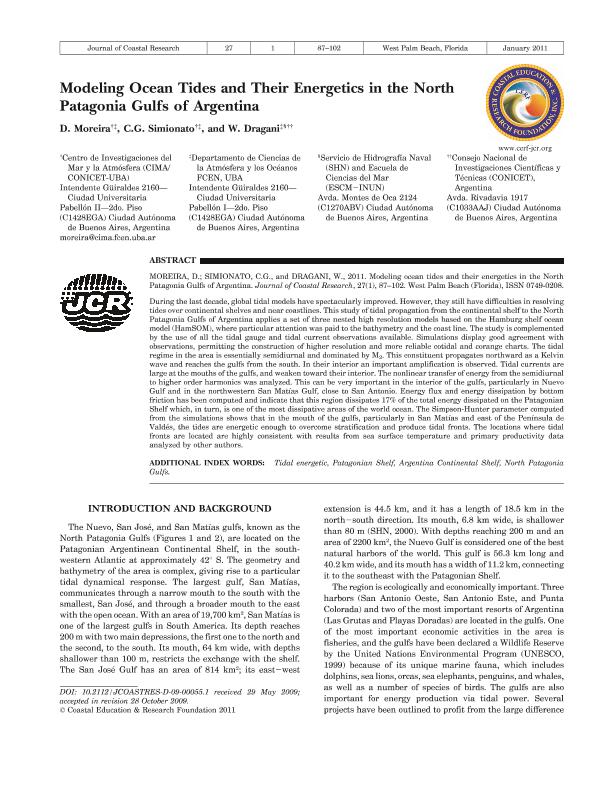Mostrar el registro sencillo del ítem
dc.contributor.author
Moreira, Diego

dc.contributor.author
Simionato, Claudia Gloria

dc.contributor.author
Dragani, Walter Cesar

dc.date.available
2020-04-13T16:25:59Z
dc.date.issued
2011-01
dc.identifier.citation
Moreira, Diego; Simionato, Claudia Gloria; Dragani, Walter Cesar; Modeling Ocean Tides and Their Energetics in the North Patagonia Gulfs of Argentina; Coastal Education & Research Foundation; Journal of Coastal Research; 27; 1; 1-2011; 87-102
dc.identifier.issn
0749-0208
dc.identifier.uri
http://hdl.handle.net/11336/102386
dc.description.abstract
During the last decade, global tidal models have spectacularly improved. However, they still have difficulties in resolving tides over continental shelves and near coastlines. This study of tidal propagation from the continental shelf to the North Patagonia Gulfs of Argentina applies a set of three nested high resolution models based on the Hamburg shelf ocean model (HamSOM), where particular attention was paid to the bathymetry and the coast line. The study is complemented by the use of all the tidal gauge and tidal current observations available. Simulations display good agreement with observations, permitting the construction of higher resolution and more reliable cotidal and corange charts. The tidal regime in the area is essentially semidiurnal and dominated by M2. This constituent propagates northward as a Kelvin wave and reaches the gulfs from the south. In their interior an important amplification is observed. Tidal currents are large at the mouths of the gulfs, and weaken toward their interior. The nonlinear transfer of energy from the semidiurnal to higher order harmonics was analyzed. This can be very important in the interior of the gulfs, particularly in Nuevo Gulf and in the northwestern San Matías Gulf, close to San Antonio. Energy flux and energy dissipation by bottom friction has been computed and indicate that this region dissipates 17% of the total energy dissipated on the Patagonian Shelf which, in turn, is one of the most dissipative areas of the world ocean. The Simpson-Hunter parameter computed from the simulations shows that in the mouth of the gulfs, particularly in San Matías and east of the Península de Valdes, the tides are energetic enough to overcome stratification and produce tidal fronts. The locations where tidal fronts are located are highly consistent with results from sea surface temperature and primary productivity data analyzed by other authors.
dc.format
application/pdf
dc.language.iso
eng
dc.publisher
Coastal Education & Research Foundation

dc.rights
info:eu-repo/semantics/openAccess
dc.rights.uri
https://creativecommons.org/licenses/by-nc-sa/2.5/ar/
dc.subject
TIDAL ENERGETIC
dc.subject
PATAGONIAN SHELF
dc.subject
ARGENTINA CONTINENTAL SHELF
dc.subject
NORTH PARAGONIAN GULFS
dc.subject.classification
Oceanografía, Hidrología, Recursos Hídricos

dc.subject.classification
Ciencias de la Tierra y relacionadas con el Medio Ambiente

dc.subject.classification
CIENCIAS NATURALES Y EXACTAS

dc.title
Modeling Ocean Tides and Their Energetics in the North Patagonia Gulfs of Argentina
dc.type
info:eu-repo/semantics/article
dc.type
info:ar-repo/semantics/artículo
dc.type
info:eu-repo/semantics/publishedVersion
dc.date.updated
2020-02-27T18:50:11Z
dc.journal.volume
27
dc.journal.number
1
dc.journal.pagination
87-102
dc.journal.pais
Estados Unidos

dc.description.fil
Fil: Moreira, Diego. Universidad de Buenos Aires. Facultad de Ciencias Exactas y Naturales. Departamento de Ciencias de la Atmósfera y los Océanos; Argentina. Consejo Nacional de Investigaciones Científicas y Técnicas. Oficina de Coordinación Administrativa Ciudad Universitaria. Centro de Investigaciones del Mar y la Atmósfera. Universidad de Buenos Aires. Facultad de Ciencias Exactas y Naturales. Centro de Investigaciones del Mar y la Atmósfera; Argentina
dc.description.fil
Fil: Simionato, Claudia Gloria. Consejo Nacional de Investigaciones Científicas y Técnicas. Oficina de Coordinación Administrativa Ciudad Universitaria. Centro de Investigaciones del Mar y la Atmósfera. Universidad de Buenos Aires. Facultad de Ciencias Exactas y Naturales. Centro de Investigaciones del Mar y la Atmósfera; Argentina. Universidad de Buenos Aires. Facultad de Ciencias Exactas y Naturales. Departamento de Ciencias de la Atmósfera y los Océanos; Argentina
dc.description.fil
Fil: Dragani, Walter Cesar. Consejo Nacional de Investigaciones Científicas y Técnicas; Argentina. Ministerio de Defensa. Armada Argentina. Servicio de Hidrografía Naval; Argentina
dc.journal.title
Journal of Coastal Research

dc.relation.alternativeid
info:eu-repo/semantics/altIdentifier/url/https://meridian.allenpress.com/jcr/article-abstract/27/1/87/28244/Modeling-Ocean-Tides-and-Their-Energetics-in-the?redirectedFrom=fulltext
dc.relation.alternativeid
info:eu-repo/semantics/altIdentifier/doi/http://dx.doi.org/10.2112/JCOASTRES-D-09-00055.1
Archivos asociados
